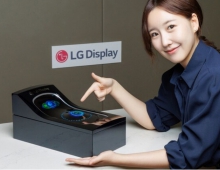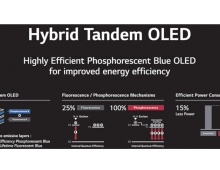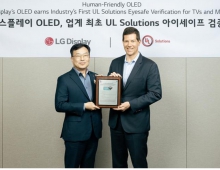
LG Display to Boost OLED Production to 2.5 mn Units
Yeo Sang-deog, head of LG Display's OLED division LG Display Co., said that his company will ramp up annual output of organic light-emitting diode (OLED) display from this year's 1.7 million to 2.5 million units next year.
Speaking at the company's first Europe OLED Day symposium in Munich, Sang-Deog Yeo, President and Chief Marketing Officer (CMO) of LG Display said "Europe offers the optimal conditions for OLED expansion, given that it has a high acceptance rate of new technologies and a high premium market portion in all industries. LG Display is committed to maximizing the expansion of the global large screen OLED market within the next two years."
The executive revealed the company's bold ambition to change the global TV market landscape after successfully expanding OLED presence in the European premium TV market.
As part of efforts to speed up the adoption of OLED TV display technology, the world's leading OLED manufacturer would boost OLED display output to 1.7 million units by the end of this year and 2.5 million units by next year, said Lee Sang-hoon, head of TV sales and marketing at LG Display.
The company will engage in more aggressive marketing schemes in Europe and cooperate with various partners and clients to win over the liquid crystal display (LCD) sector and another premium TV display technology, the quantum dot-based display, promoted by its archrival Samsung Display Co.
The Korean display maker celebrated the Europe OLED Day with major electronics firms including LG Electronics, Loewe, Bang & Olufsen and Philips.
LG Display claims that OLED TV delivers the Holy Grail of visuals: perfect black, vivid color reproduction and high contrast ratios. This makes it the ideal fit for HDR. OLED also offers wide viewing angles.
In design, OLED offers infinite possibilities as it is transparent, rollable, and foldable. Thanks to its structural characteristics - it requires no backlight and liquid crystal - it can also be super slim. The Munich symposium showcased LG Display's current and future OLED products such as 65- and 77-inch UHD Wallpaper OLED displays, 55- and 65-inch UHD Crystal Sound OLED (CSO), 65-inch UHD Concave CSO as well as next-gen panels such as 18.1-inch rollable OLED and 12.3-inch plastic OLED for automobiles.
Samsung, which is promoting its own QLED screens, said on said Tuesday the organic light-emitting diode technology is not suitable for use on television sets.The South Korean tech giant said OLED displays are only suitable for devices with shorter life expectancies, such as smartphones, due to the so-called screen burn-in, or image retention, saying the case is different for TVs and monitors, which are normally used for longer periods.
As organic light-emitting diode displays are used in more smartphones and high-end flat panel TVs, panel makers have boosted their investments in new OLED display fab construction. The global production capacity of AMOLED panels -- including both red-green-blue (RGB) OLED and white OLED (WOLED) -- is forecast to surge 320 percent from 11.9 million square meters in 2017 to 50.1 million square meters in 2022, according to analysis from IHS Markit.
The two market leaders -- Samsung Display and LG Display -- have taken different paths: Samsung is focusing on RGB OLED panels for mobile devices, and LG on WOLED displays for TVs. To cope with the trend of RGB OLED replacing the liquid crystal display (LCD) in smartphones and other mobile devices, especially for the full-screen and flexible feature of OLED panels, LG Display has started to manufacture RGB OLED panels in 2017. Meanwhile, Chinese panel makers, including BOE, ChinaStar, Tianma, Visionox, EverDisplay, Truly and Royole, are all expanding the production capacity of RGB OLED panels, targeting the mobile market.
IHS Markit analysts expect Samsung Display to remain the dominant supplier of the RGB OLED panels for smartphones. Its RGB OLED panel capacity will grow from 7.7 million square meters in 2017 to 16.6 million square meters in 2022, IHS Markit says. Even though many Chinese panel makers are building RGB OLED fabs, each of their production capacity is much smaller than that of Samsung Display. Due to the gap in their production capacities, they will target different customers: Samsung Display will mainly focus on two major customers -- Samsung Electronics (the Galaxy) and Apple (the iPhone), while Chinese makers will be targeting at Chinese smartphone makers at a smaller scale. These include Huawei, Xiaomi, Vivo, Oppo, Meizu, Lenovo and ZTE, and white box makers.
South Korea's panel makers are estimated to account for 93 percent of the global AMOLED production capacity in 2017, and their share is expected to drop to 71 percent in 2022. Chinese players (BOE, ChinaStar, Tianma, Visionox, EverDisplay and Royole) will account for 26 percent in 2022 from 5 percent in 2017.





















